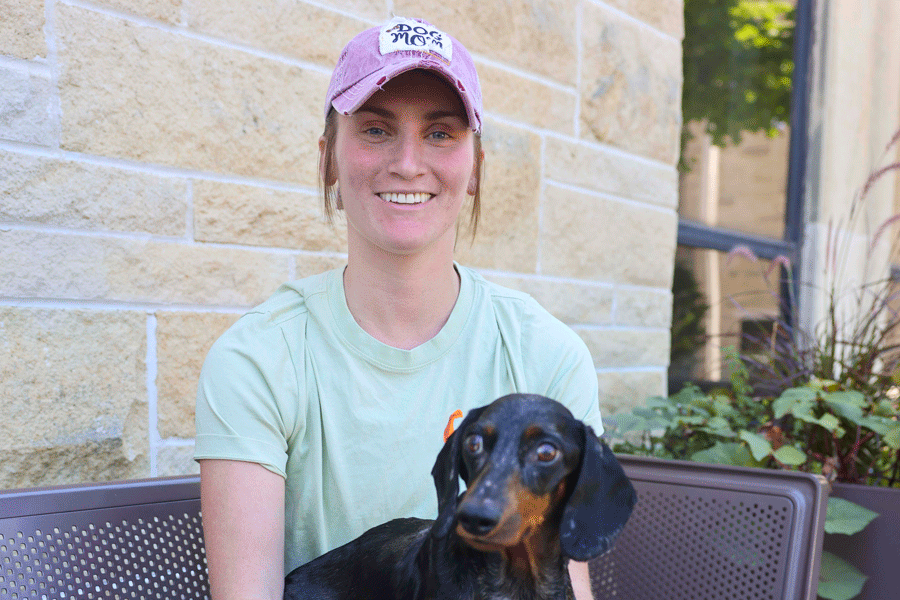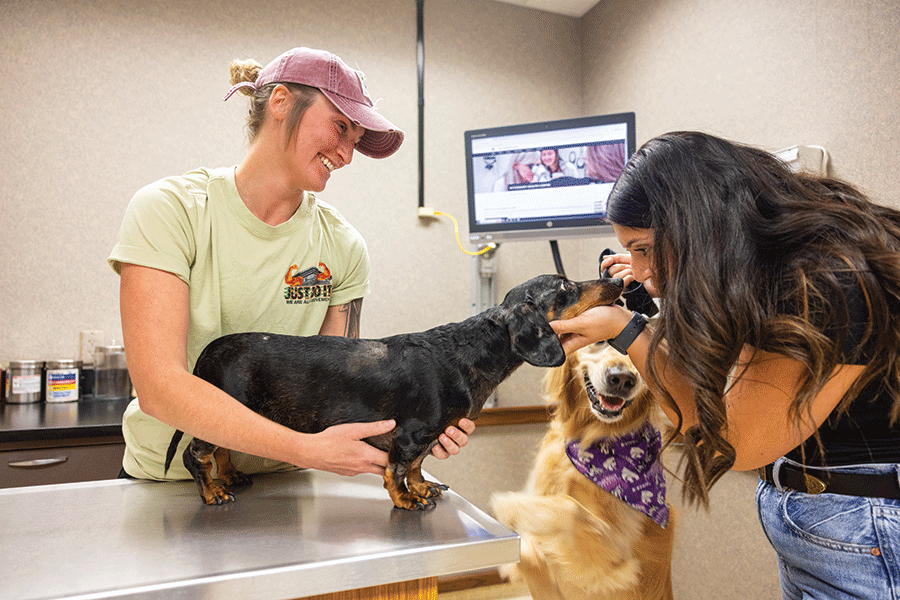Crushin' It
How canine blood donors save lives and inspire hope.
Story by Rylee Coy and photos by Audrey Hambright
Photo caption top: Trista and Crush reconnect with their care team at VHC on the day of their meet-and-greet with Crush’s blood donor, Benton. From left to right: Dr. Caylie Voudren, Trista Rich, Brooke Nieberger and Mya Croy.
Just like humans, animals sometimes face medical emergencies that require blood transfusions. Whether the need arises from a disease, injury or surgery, access to canine blood products can mean the difference between life and death. Unlike human blood banks, canine blood supplies rely on the generosity of the dog owners who enroll their pets in blood donor programs.
At the Veterinary Health Center, the Canine Blood Donor Program plays a vital role in providing this lifesaving resource. Each donation not only saves the lives of two dogs but also highlights the unique bond between animals and the humans who care for them.
Trista and her dog Crush, sit in front of the VHC where Crush received lifesaving care.
Need for blood
Trista Rich and her then 6-year-old miniature dachshund, Crush, first visited the Veterinary Health Center in March 2022 for emergency back surgery. A follow-up visit was needed to resolve some platelet issues, but not long afterward, another medical complication appeared.
“In April of 2024, Crush was diagnosed with immune mediated hemolytic anemia,” Trista says. “He was extremely low on his red blood cells.”
Originally, Trista noticed that Crush’s gums were pale, but thought it could have been caused by a separate medical condition.
“We ended up bringing him in because we noticed his heart rate was high,” Trista says. “They did a blood test and found that his percentage of red blood cells was low. At that point, we had to do a blood transfusion.”
Without blood, Crush would have risked damage to his organs.
“[The doctors] think he started to lose oxygen in his GI tract,” Trista says. “The only way to revitalize his organs would have been through the blood transfusion we gave him.”
Lifesaving donation
Mya Croy, first-year student and owner of a 4-year-old golden retriever named Benton, were involved in the canine blood donor program. Benton’s donations meant blood Crush needed for his recovery was available.
“I have wanted to be a veterinarian my entire life,” Mya says. “I love helping animals and helping their owners. When I saw there was an opportunity for Benton to help other animals, I thought it was a no-brainer and signed him up.”
Benton’s blood donations have facilitated other forms of treatment for many patients in need. Since joining the blood donor program in February 2023, he has donated a total of seven times.
“With the disease Crush has, we have to give him steroids,” Trista says. “The steroids take a little bit to start working. The transfusion gave Crush time to revitalize his organs and start pumping some of his own red blood cells out.”
Trista says she appreciates the importance of blood donations being available.
“Without the transfusion, he may have lost oxygen to some of his organs,” Trista says. “He wouldn’t be to the point he is today.”
At the time of publication, Crush is doing “beyond wonderful” and has blood volume levels of normal dogs.
Need for canine blood donors
Benton’s role highlights the importance of canine blood donations.
“A lot of people don’t know how many animals need blood transfusions,” Mya says. “Bringing more awareness to it is important. I tell all my friends and family that have big dogs to come to K-State to see if their dog is able to donate blood.”
Each unit of blood can save two dogs’ lives — and there are benefits for the donors. Dogs in the program receive free annual vaccinations, preventatives and blood work. Participants receive a bag of dog food with each blood donation.“What we are doing with the blood donor program is helping those dogs continue on,” says Brooke Neiberger, RVT, veterinary nurse and coordinator of the Canine Blood Donor Program.
Trista and Crush meet the canine blood donor, Benton and Mya.

How blood donation works
To be screened to participate in the program, dogs should be between the ages of 1 and 5. They also should weigh more than 55 pounds. Other initial requirements include:
- Good temperament: will lay on side for five-10 minutes
- Never received a blood transfusion
- Females spayed (No previous litters); males neutered
- Available for collection every two months
- Dog owners live within a 30-minute driving distance of the VHC
After these requirements are met, the potential donor will have a physical exam and are tested for their blood type. If dogs test negative for Dog Erythrocyte Antigen 1.1, they will move onto the general health and infectious screening portion of the screening process.